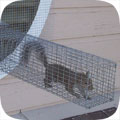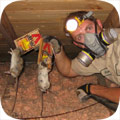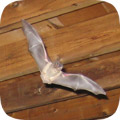- katy@wildlifeanimalcontrol.com
Call 24/7 for a free quote:
281-336-0383
Katy Wildlife Animal Control
Professional Wildlife Removal Company Servicing Katy, TX
If you have a problem with wildlife in your Katy home, your best option is to hire a company that specializes in Texas wildlife removal only. This is a specialty business, and regular pest control companies do not use the proper techniques to solve animal problems. I have spent many years reviewing Texas and Katy, and I recommend the following:
Wildlife Removal of Katy
Cell Phone: 281-336-0383
NOTE: If you have a dog or cat problem, call Harris County Animal Services: (281) 391-4740

Wildlife Removal of Katy specializes primarily in removing animals from attics of homes and buildings - this includes squirrels in attics, raccoons, and rats or mice in homes. Texas also has a documented problem with
bats in buildings, and Wildlife Removal of Katy is specially trained in bat removal. They also perform general wildlife trapping services, such as the capture and removal of skunks or opossums on the
property. Call 281-336-0383 to discuss your critter problem and schedule a same-day or next-day appointment. Click here to learn more about
what prices we charge in 2025.
When hiring a company to solve your wild animal problem, you want these features:
- Specializes in wildlife removal, not pest control
- Fully Texas and Harris County licensed and insured
- Works 7 days per week (critters don't take weekends off)
- Performs full building inspections: enters and inspects attic
- Performs exclusion repairs, with guarantee against animal re-entry
- Offers cleanup of biohazardous wildlife waste
Wildlife Removal of Katy is a full-service Katy wildlife removal company. This is very different from a regular Katy pest control company. The pest control companies spray poison to kill insects. This is not at all
similar to wildlife removal. Wildlife Removal of Katy performs a full inspection of the home or property, and determines why the animal(s) are there, and if inside a building, how the animals got inside. All
animals (including rodents) are trapped and removed, or if possible, removed from the building using special exclusion devices. Once the animals are gone, preventative repairs are essential, and
cleanup is sometimes recommended.
 Katy wildlife trapping - it's not as simple as it may seem. It's illegal in Texas to trap without a license. Trap type is very important and there are many different types, bait is somewhat relevant, trap placement
is vital, and there are dozens of small things that are very important to know.
Safety is a concern. Then once the animal is trapped, it must be removed and dealt with in the proper manner according to Texas law. We offer Katy raccoon removal. Read more about how to get rid of raccoons.
Katy wildlife trapping - it's not as simple as it may seem. It's illegal in Texas to trap without a license. Trap type is very important and there are many different types, bait is somewhat relevant, trap placement
is vital, and there are dozens of small things that are very important to know.
Safety is a concern. Then once the animal is trapped, it must be removed and dealt with in the proper manner according to Texas law. We offer Katy raccoon removal. Read more about how to get rid of raccoons.
 Animals in attics - this is our specialty at Wildlife Removal of Katy. Many types of animals like to live in attics. This includes squirrels, raccoons, rats, mice, bats, birds, and even possums. Critters like to go into attics for a safe place to live
and raise their young. Removing animals from attics is very complex work, partly because of the presence of baby animals. If you need Katy squirrel removal, we can remove all the squirrels from your attic, and seal out any future ones. Read more about how to get rid of squirrels.
Animals in attics - this is our specialty at Wildlife Removal of Katy. Many types of animals like to live in attics. This includes squirrels, raccoons, rats, mice, bats, birds, and even possums. Critters like to go into attics for a safe place to live
and raise their young. Removing animals from attics is very complex work, partly because of the presence of baby animals. If you need Katy squirrel removal, we can remove all the squirrels from your attic, and seal out any future ones. Read more about how to get rid of squirrels.
 Rodent control must be done in a very specific way. First off, the most important thing is that all the openings that rats and mice can use to enter a house be sealed. Then all the rodents must be physically trapped and removed.
Never, ever use poison! Most Katy exterminators will just use this lazy poison technique to kill rodents, and it causes more harm than good - dead stinky rats, and it doesn't solve the problem. Call us for correct Katy rat removal. Read more about how to get rid of rats.
Rodent control must be done in a very specific way. First off, the most important thing is that all the openings that rats and mice can use to enter a house be sealed. Then all the rodents must be physically trapped and removed.
Never, ever use poison! Most Katy exterminators will just use this lazy poison technique to kill rodents, and it causes more harm than good - dead stinky rats, and it doesn't solve the problem. Call us for correct Katy rat removal. Read more about how to get rid of rats.
 Bat removal is a highly specialized task. Texas is known to have colonizing bats who often live in buildings. Bats love attics. If not removed, the colony can grow to a very large size over the years. The bat droppings are often corrosive and
cause health risks. The same goes for bird droppings on or in buildings. We perform Katy pigeon removal and bird control. But our specialty is Katy bat removal. We remove 100% of the bat colony and seal the building so that it's totally bat-proof. Read more about how to get rid of bats.
Bat removal is a highly specialized task. Texas is known to have colonizing bats who often live in buildings. Bats love attics. If not removed, the colony can grow to a very large size over the years. The bat droppings are often corrosive and
cause health risks. The same goes for bird droppings on or in buildings. We perform Katy pigeon removal and bird control. But our specialty is Katy bat removal. We remove 100% of the bat colony and seal the building so that it's totally bat-proof. Read more about how to get rid of bats.
 If you have animals inside a house, no job is complete without proper exclusion repairs. If you simply hire a Katy trapper who only removes the critters, then the problem will return. You need to hire a Katy wildlife control company that identifies 100% of the animal entry points
into your building, and seals them shut with professional repairs. In addition, in many cases animals have left waste or contamination behind, and you'll want a company that can provide professional cleaning services. Wildlife Removal of Katy does both.
If you have animals inside a house, no job is complete without proper exclusion repairs. If you simply hire a Katy trapper who only removes the critters, then the problem will return. You need to hire a Katy wildlife control company that identifies 100% of the animal entry points
into your building, and seals them shut with professional repairs. In addition, in many cases animals have left waste or contamination behind, and you'll want a company that can provide professional cleaning services. Wildlife Removal of Katy does both.
The above are just some of the services offered by Wildlife Removal of Katy. We also trap and remove animals that destroy lawns, such as moles, or digging animals. Sometimes animals like opossums will live under buildings, steal pet food, raid garbage cans, etc.
Read about how to get rid of opossums. Skunks commonly live under sheds or decks, and set up a den. We can trap and remove them without them spraying. Read about how to get rid of skunks. Wildlife Removal of Katy
also provides dead animal removal in Katy. If you need help with any other wildlife conflict, from a fox, beaver, groundhog, or any other critter, we can solve it. We also do Katy snake removal - most of the snakes in Texas are not venomous, but
call us if you want safe removal, or read about how to get rid of snakes in Katy. And remember, we are a private business, not Harris County Animal Control Services, so if you have a dog or cat problem, call the County at (281) 391-4740.
Harris County animal services does not handle any wildlife issues.
Wildlife Removal of Katy
Cell Phone: 281-336-0383
Katy Pricing Info
Every wildlife removal situation is different, from the species of animals involved, the location of the animal inside a house or outside, the extent of repairs or cleanup, etc. It's impossible to give one-size-fits-all prices. Examples MIGHT include:Small Job: For example, a one-stop job to remove an animal in the yard: $100 on up
Medium Job: For example, getting critters out of your house with minor repairs: $300 on up
Large Job: For example, a project involving many service trips and complex work: $500 on up
Give us a phone call now and tell us about your wildlife issue and we will be able to give you a price estimate over the phone. If you're cool with it, we can schedule a same-day or next-day appointment if you like. Our prices are fair, and a good value because we do the job right, the first time.
Katy Wildlife Tip #1:
Do Skunks Dig in Lawns Looking for Food?
Yes, skunks dig in lawns looking for food. In the late summer and early fall, people are waking up to find holes and mounds in their lawns. One night of digging can damage a significant area of the lawn. These nocturnal animals are looking for food. The skunks have sharp front claws that they use to dig the holes. Skunks don't jump and are very poor climbers, so they are restricted to gathering food from the ground. Damage is made to lawns, gardens and golf courses as the gluttonous skunks dig for mice, small birds, bird eggs, fish, grubs, other insects, and garbage. Their favorite food is insects.
In urban and suburban locations the skunks may dig under residential structures. These can be decks, or porches; even concrete slabs. It is not surprising that this digging can cause structural damage. The skunks make clear-cut, cone shaped, shallow holes that can be from 1 to 3 inches in diameter as while digging for an insect and then the next. There can be such a large number of holes that they consolidate into an area that looks like plowed ground.
Skunks are attracted to homes that have food available. They are looking for things like bird feeders, garbage, lawn grubs or pet food. Homes that have crawl spaces, porches or any area with open spaces underneath where the skunks can feel safe are attractive to them. Check your home to make sure you are not inviting skunks for a meal.
There are serious health risks of having skunks on your property. Skunks carry zoonotic diseases. A zoonotic disease is spread between animals and people. Zoonotic diseases include leptospirosis (a bacterial infection that attacks the body's nervous system and organs), and an intestinal roundworm. They are leading carriers of rabies. Since skunks are nocturnal, you should be very careful around any that you see active during the day. Skunks also carry distemper. Distemper is a viral disease that can be very harmful to dogs. In addition skunks carry a ticks, fleas, and mites; which each carry a number of diseases.
There is also the most obvious of characteristics of a skunk, the odor. The nocturnal nature of the skunk makes it less likely that you will encounter one during the day. It is also good to know that they spray as a last resort. It would be a good idea to keep supplies on hand for skunk spray removal if you notice the evidence of skunks in your yard.
Katy Wildlife Tip #2:
Texas Wildlife Information:
Texas State bird: Northern mockingbird
State mammal: Nine-banded armadillo, Texas longhorn, Mexican free-tailed bat
State reptile: Texas horned lizard
State amphibian: Texas Toad
State fish: Guadalupe bass
State insect: Monarch butterfly
Texas, the second largest state in the United States, has multiple climate regions, and thus very unpredictable weather patterns. Not only can Texas have tornados, it can be hit with devastating hurricanes or extended periods of drought. West Texas often sees snow, whereas East Texas is almost always hot and dry. Some areas receive ample rain; some areas receive none. All of this variability means any animals living in Texas need to be ready for just about anything.
The regions in Texas where vegetation is scarce and the sun beats down are the prime locations for the many different lizard species living in the state. Of those, the Texas horned lizard spends its days eating the ample supply of ants which also thrive in the dry environment. The desert tortoise also likes to spend time out in the sun, eating prickly pear fruit. Unfortunately, these critters who love to be out in the open are often prey to one of Texas's largest nuisance animals, the coyote. More a bane to farmers, coyotes are opportunistic creatures, smart enough to evade capture and devious enough to break through inadequate fencing. Other large Texas predators, like the cougar and the bobcat, tend to be leery of people, spending most of their time in the scrub forests surrounding rivers like the Rio Grande.
A lack of large predators does not give the state any break from nuisance animals, however. Just like other, smaller states, Texas has significant issues with rodent infestations, including that of rats, mice, and squirrels. Another small animal pest, though not a rodent, is the Mexican free-tail bat, a common creature in the Texas skies at dusk. Bats love to take up residence in attics around the region, and because most areas in Texas are mild during the winter months, the bats will remain all year.
Armadillos also make their presence known in yards around the state. Texas is naturally dry, and a lush yard, which is likely irrigated, will hold a much more enticing amount of bugs for the armored critter. An armadillo can do serious damage to a yard in just one night. If that's not enough, Texas has a good number of both venomous and non-venomous snakes, all of which will be drawn to places with water supplies; aka: pools and ponds.
You can always call Wildlife Removal of Katy, any time of day, at 281-336-0383, for a price quote for Katy wildlife control services. I am confident that this is the best choice amongst wildlife removal companies in Katy, TX.







































